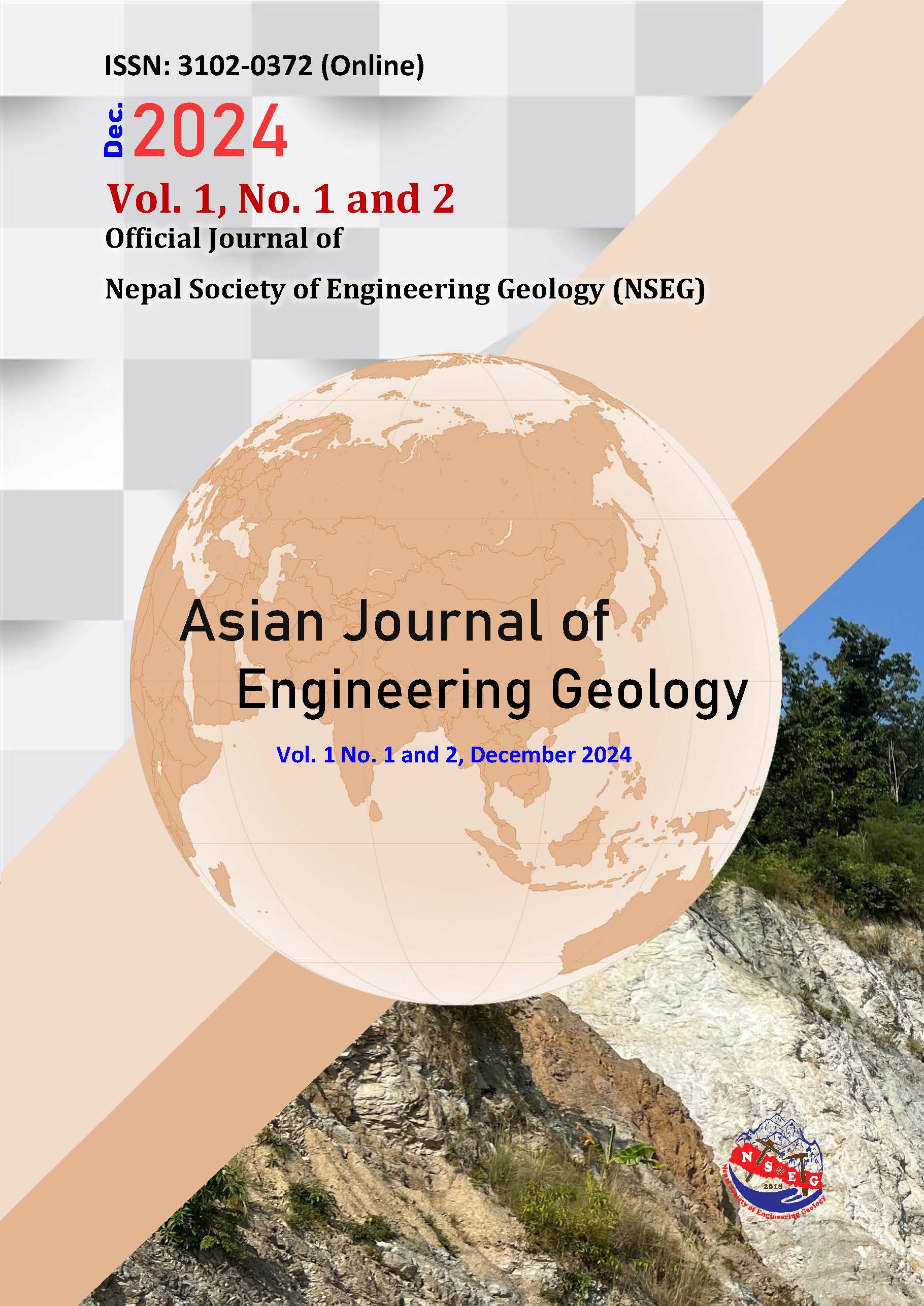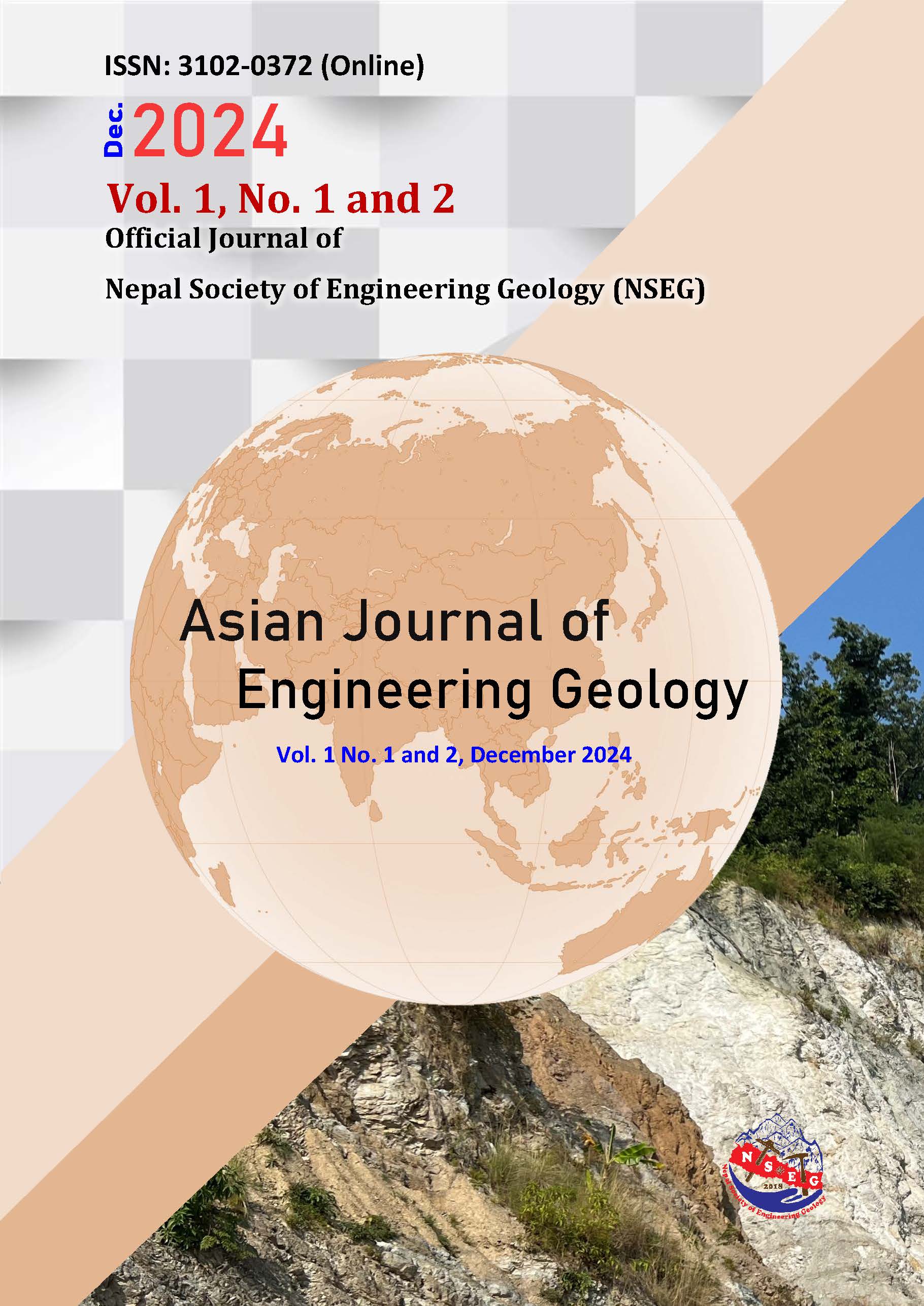Engineering Geological Challenges Following the 2024 Noto Earthquake, Japan
DOI:
https://doi.org/10.64862/ajeg.112.02Keywords:
The 2024 Noto Earthquake, Post-disaster Assessment, Seismic hazards, Liquefaction, LandslidesAbstract
The 2024 Noto Peninsula (Noto-Hanto) earthquake significantly impacted infrastructure and communities in Central Japan, unveiling critical engineering geological challenges. To our knowledge, this paper presents the first systematic field survey conducted eight months after the mainshock, focusing on the post-disaster phenomenon and their recovery states. Through ground visits, satellite imagery analyses, and high-resolution DEM differencing, we identified persistent deep-seated gravitational slope deformation (DGSD) undermining tunnel stability, land uplift, structural collapses from soil liquefaction, and several landslides, with rural areas experiencing severe impacts. Our observations reported that the crustal uplift has permanently altered hydrological regimes and DGSD remains active beneath major tunnels, inducing tunnels spalling. Slope failures have progressed under cumulative rainfall loading, and tunnel linings show evolving structural distress linked to both DGSD and residual seismic damage. Lateral spreading, ground upheaval, ground settlement, sinking of utility poles, and the presence of sand ejecta are found as the major indicators of liquefaction. The study also evaluates the efficacy of current mitigation and restoration efforts. The Ishikawa`s structured, community‐focused model demonstrates a clear path toward more efficient, resilient recovery, despite lingering delays in damage repair work. This study further emphasizes the significance of proactive, long-term disaster risk reduction to minimize future earthquake-related impacts.
References
Dahal (2015). Engineering geological issues after Gorkha Earthquake 2015 in Nepal—a preliminary understanding. 10th Asian Regional Conference of IAEG, Kyoto, Japan.
DesRoches R., Comerio M., Eberhard M., Mooney W. and Rix G.J. (2011). Overview of the 2010 Haiti earthquake. Earthquake Spectra 27, 1–21. https://doi.org/10.1193/1.3630129
Disaster Prevention, Safety and Security, Ishikawa Prefecture (2024). Information on the Noto Peninsula Earthquake in 2024 by purpose. https://www.pref.ishikawa.lg.jp/saigai/202401jishin-taisakuhonbu.html#higai (in Japanese). Accessed on 6 Sept 2024.
Fukushima Y., Ishimura D., Takahashi N., Iwasa Y., Malatesta L.C., Takahashi T., Tang C.H., Yoshida K. and Toda S. (2024). Landscape changes caused by the 2024 Noto Peninsula earthquake in Japan. Science Advances 10, eadp9193. https://doi.org/10.1126/sciadv.adp9193
Fukushima Y., Nishikawa T. and Kano Y. (2023). High probability of successive occurrence of Nankai megathrust earthquakes. Scientific Reports 13, 63. https://doi.org/10.1038/s41598-022-26455-w
Geospatial Information Authority of Japan. (2024). Coastline change caused by the 2024 Noto Peninsula Earthquake detected by ALOS-2 SAR satellite image (Jan. 4, 2024). Retrieved from https://www.gsi.go.jp/uchusokuchi/uchusokuchi-e31001.html. Accessed on 8 Sept 2024.
Gomez C. (2024). The January 1st 2024 Noto Peninsula co-seismic landslides hazards: preliminary results. 31 January 2024, PREPRINT (Version 1) available at Research Square https://doi.org/10.21203/rs.3.rs-3904468/v1
Himematsu Y., Furuya M. (2020). Coseismic and postseismic crustal deformation associated with the 2016 Kumamoto earthquake sequence revealed by PALSAR-2 Pixel tracking and InSAR. Earth and Space Science 7, e2020EA001200. https://doi.org/10.1029/ 2020EA001200
Honda R., Hiramatsu Y., Kono Y. and Katagawa H. (2008). Gravity anomalies and the geologic block structures in and around the aftershock area of the 2007 Noto Hanto Earthquake. Earth, Planets and Space 60, 111–115. https://doi.org/10.1186/BF03352770
Ishikawa Noto Earthquake Interim Report (2024). Retrieved from https://pbv.or.jp/wp_en/wp-content/uploads/2024/06/ENG_2024_Noto-Report.pdf. Accessed on 15 Sept 2024.
Ishikawa Y. and Bai L. (2024). The 2024 Mj 7.6 Noto Peninsula, Japan earthquake caused by the fluid flow in the crust. Earthquake Research Advances 4, 100292. https://doi.org/10.1016/j.eqrea.2024.100292
Itatani T., Kojima M., Tanaka J., Horiike R., Sibata K. and Sasaki R. (2024). Operational management and improvement strategies of evacuation centers during the 2024 Noto Peninsula earthquake—a case study of Wajima city. Safety 10, 62. https://doi.org/10.3390/safety10030062
Kamiyama M., Koide H., Sawada Y., Akita H. and Chiba N. (2017). Monitoring of crustal deformation and its application to mitigation of earthquake disasters. Journal of JSCE 5, 206–225. https://doi.org/10.2208/journalofjsce.5.1_206
Kataoka K., Urabe A., Nishii R., Matsumoto T., Niiya H., Watanabe N., Kawashima K., Watabe S., Takashimizu Y., Fujibayashi N. and Miyabuchi Y. (2024). Extensive liquefaction and building damage on the Niigata Plain due to the 1 January 2024 Noto Peninsula Earthquake: Geomorphological and geological aspects and land-use in coastal and lowland areas, EGU General Assembly 2024, Vienna, Austria, 14–19 Apr 2024, EGU24-22541, https://doi.org/10.5194/egusphere-egu24-22541.
Kato A. (2024). Implications of fault-valve behavior from immediate aftershocks following the 2023 M6.5 earthquake beneath the Noto Peninsula, Central Japan. Geophysical Research Letters 51, e2023GL106444. https://doi.org/10.1029/2023GL106444
Kazama M. and Noda T. (2012). Damage statistics (summary of the 2011 off the Pacific Coast of Tohoku Earthquake damage). Soils and Foundations, Special issue on geotechnical aspects of the 2011 off the Pacific Coast of Tohoku Earthquake 52(5), 780–792. https://doi.org/10.1016/j.sandf.2012.11.003
Kuribayashi K., Hara T., Sakabe A. and Kuroda S. (2021). A study on road embankment damage on liquefied ground. Journal of the Japan Association for Earthquake Engineering 21(1):46-1_63. (In Japanese). https://doi.org/10.5610/jaee.21.1_46
Liu C., Fang D. and Zhao L. (2021). Reflection on earthquake damage of buildings in 2015 Nepal earthquake and seismic measures for post-earthquake reconstruction. Structures 30, 647–658. https://doi.org/10.1016/j.istruc.2020.12.089
Loi D.H., Jayakody S., Sassa K., Konagai K., Hirota K., Ono A., Takanaka T., Oki T. and Minamitani T. (2024). Landslides triggered by the 2024 Noto Peninsula earthquake. Landslides 21:2583–2590 https://doi.org/10.1007/s10346-024-02333-6
Mizuno C., Wang X. and Dang J. (2024). A fast survey report about bridge damages by the 2024 Noto Peninsula Earthquake. Earthquake Research Advances 5(4):100312. https://doi.org/10.1016/j.eqrea.2024.100312
Nishimura T., Hiramatsu Y. and Ohta, Y. (2023). Episodic transient deformation revealed by the analysis of multiple GNSS networks in the Noto Peninsula, central Japan. Scientific Reports 13, 8381. https://doi.org/10.1038/s41598-023-35459-z
Ohno H., Tsutsumi D., Furuya G., Takiguchi S., Ikeda M., Miyagi A., Miike T. and Sawa Y. (2024). Sediment-related disasters induced by the Noto Peninsula Earthquake in January 2024. International Journal of Erosion Control Engineering 17(4):42–50. https://doi.org/10.13101/ijece.17.42
Pai L. and Wu H. (2021). Multi-attribute seismic data spectrum analysis of tunnel orthogonal underpass landslide shaking table test. Soil Dynamics and Earthquake Engineering 150, 106889. https://doi.org/10.1016/j.soildyn.2021.106889
Peng X., Wang F., Miyajima M., Yoshida M., Zhang S. and Fu Z. (2025). Brief report of a field investigation in Noto Peninsula, Japan, after the 2024 Noto earthquake. Geoenvironmental Disasters 12, 11. https://doi.org/10.1186/s40677-025-00315-x
Seno T., Stein S. and Gripp A.E. (1993). A model for the motion of the Philippine Sea Plate consistent with NUVEL-1 and geological data. Journal of Geophysical Research: Solid Earth 98, 17941–17948. https://doi.org/10.1029/93JB00782
Setiawan H., Serikawa Y., Nakamura M., Miyajima M. and Yoshida M. (2017). Structural damage to houses and buildings induced by liquefaction in the 2016 Kumamoto Earthquake, Japan. Geoenvironmental Disasters 4, 13. https://doi.org/10.1186/s40677-017-0077-x
Shishikura M., Echigo T. and Namegaya Y. (2009). Evidence for coseismic and aseismic uplift in the last 1000 years in the focal area of a shallow thrust earthquake on the Noto Peninsula, west-central Japan. Geophysical Research Letters 36. https://doi.org/10.1029/2008GL036252
Subedi M. and Acharya I.P. (2022). Liquefaction hazard assessment and ground failure probability analysis in the Kathmandu Valley of Nepal. Geoenvironmental Disasters 9, 1. https://doi.org/10.1186/s40677-021-00203-0
Suppasri A., Kitamura M., Alexander D., Seto S. and Imamura F. (2024). The 2024 Noto Peninsula earthquake: preliminary observations and lessons to be learned. International Journal of Disaster Risk Reduction 110, 104611. https://doi.org/10.1016/j.ijdrr.2024.104611
Takeda K. and Inaba K. (2022). The damage and reconstruction of the Kumamoto earthquake: an analysis on the impact of changes in expenditures with multi-regional input–output table for Kumamoto Prefecture. Journal of Economic Structures 11, 20. https://doi.org/10.1186/s40008-022-00276-6
The Japan News (2024). Earthquake damage in Ishikawa, Toyama, Niigata Prefectures estimated to cost up to ¥2.6 Trillion. https://japannews.yomiuri.co.jp/society/noto-peninsula-earthquake/20240126-164732/. Accessed on 13 Sept 2024.
Toda S. and Stein R.S. (2024). Intense seismic swarm punctuated by a magnitude 7.5 Japan shock. Temblor.net. https://temblor.net/temblor/intense-seismic-swarm magnitude-7-5-japan-earthquake-15891/. Accessed on 26 Aug 2024.
Uchida N. and Bürgmann R. (2021). A decade of lessons learned from the 2011 Tohoku-Oki earthquake. Reviews of Geophysics 59(2):e2020RG000713. https://doi.org/10.1029/2020RG000713
Umeda K., Yamazaki Y. and Sumino H. (2024). Geochemical signature of deep fluids triggering earthquake swarm in the Noto Peninsula, Central Japan. Geophysical Research Letters 51, e2024GL108581. https://doi.org/10.1029/2024GL108581
USGS (2024). M 7.5 - 2024 Noto Peninsula, Japan Earthquake.https://earthquake.usgs.gov/earthquakes/eventpage/us6000m0xl/executive. Accessed on 16 Sept 2024.
Verdugo R. and González J. (2015). Liquefaction-induced ground damages during the 2010 Chile earthquake. Soil Dynamics and Earthquake Engineering 79, 280–295. https://doi.org/10.1016/j.soildyn.2015.04.016
Wakamatsu K., Senna S. and Ozawa K. (2017). Liquefaction during the Kumamoto Earthquakes on April 14 and 16, 2016. Lowland Technology International Journal 19(3):191–202. Retrieved from https://cot.unhas.ac.id/journals/index.php/ialt_lti/article/view/517/408. Accessed on 25 Aug 2024.
Wang Q.Y., Cui X., Frank W.B., Lu Y., Hirose T. and Obara K. (2024). Untangling the environmental and tectonic drivers of the Noto earthquake swarm in Japan. Science Advances 10(19):eado1469. https://doi.org/10.1126/sciadv.ado1469
Wartman J., Dunham L., Tiwari B. and Pradel D. (2013). Landslides in Eastern Honshu Induced by the 2011 Tohoku Earthquake. Bulletin of the Seismological Society of America 103 (2B):1503–1521. https://doi.org/10.1785/0120120128
Xu C., Ma S., Tan Z., Xie C., Toda S. and Huang X. (2017). Landslides triggered by the 2016 Mj 7.3 Kumamoto, Japan, earthquake. Landslides 15, 551–564. https://doi.org/ 10.1007/s10346-017-0929-1
Yamazaki F. and Murao O. (2000). Vulnerability functions for Japanese buildings based on damage data from the 1995 Kobe earthquake, in: Implications of Recent Earthquakes on Seismic Risk, Series on Innovation in Structures and Construction. Published by Imperial College press and distributed by world scientific publishing co., pp. 91–102. https://doi.org/10.1142/9781848160194_0007
Yang D., Minami M., Fahim A. U. and Kawashita T. (2024). A timeline-based study of the early reconstruction phases in Ishikawa Prefecture following the 2024 Noto Peninsula earthquake. Sustainability, 16(24):10838. https://doi.org/ 10.3390/su162410838
Downloads
Published
Issue
Section
License
Copyright (c) 2024 Nepal Society of Engineering Geology (NSEG)

This work is licensed under a Creative Commons Attribution 4.0 International License.




